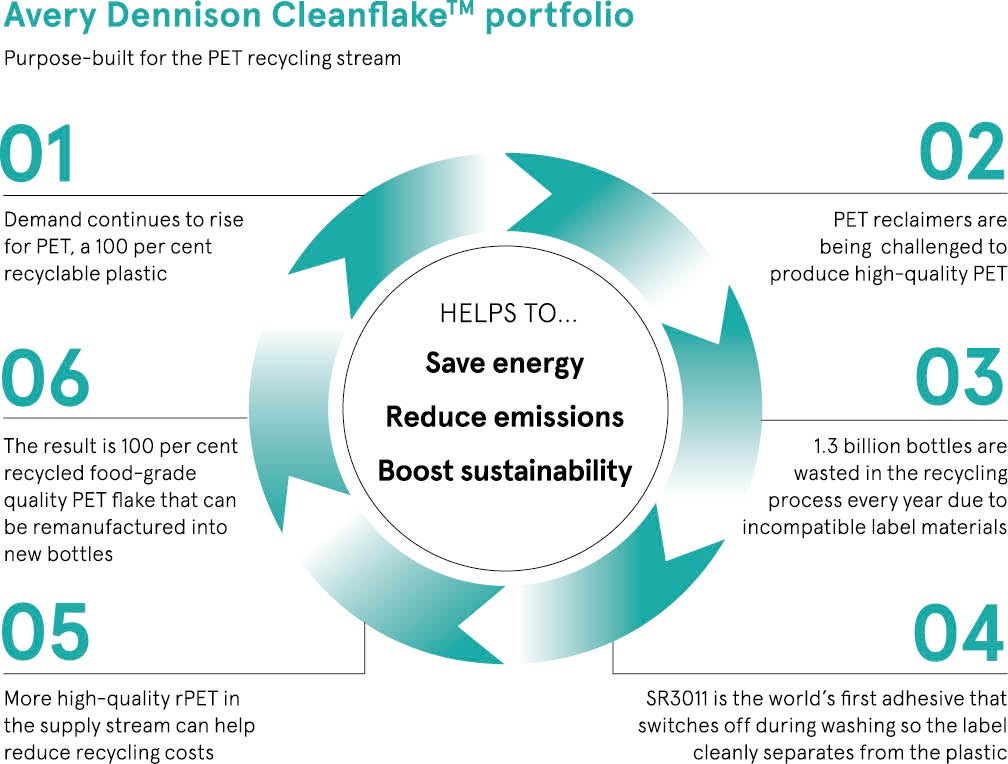
How have consumer attitudes towards sustainable packaging changed?
Sustainability has been important in the labelling and packaging industry for some time, but has become even more important recently as consumers are more aware of the impact of waste. Consumers expect the brands they purchase from to be good corporate citizens and fully transparent about the sustainability of the product itself, and the labelling and packaging. How the material is made is important, but more so is the impact it has on the overall recyclability of the package and its end of life. Consumers are
increasing the pressure on brands to take responsibility and to create more sustainable design.
To what extent is the packaging industry thinking about sustainable design differently?
Sustainability has become much more about whole system thinking. Historically there has been a focus mainly on the materials, such as FSC (Forest Stewardship Council) paper and reduced material consumption. That’s still important, but now the emphasis is really about the whole life cycle of the packaging. For example, how can you reduce materials in the original design? How can you ensure the packaging can be recycled? And how can you manage the waste created through the production of the labeling and packaging? While we have portfolios of recycled content materials, a large part of our focus is on thinking holistically about our supply chain to reduce overall waste, increase recyclability and innovate to zero.
How is sustainability influencing the way food is labelled and packaged?
Reduce, reuse and recycle remain the key influences of sustainable design. How can we reduce the materials used in the original design, how can that packaging be reused, and how can the labelling and packaging be made from more recycled content or be more easily recycled? With whole system thinking, we also need to consider the whole life cycle of the product. For example, our food reclosure solutions combine oxygen barrier films with easy open and reclosing functionality that are ideal for preventing oxygen and moisture from entering food packaging. This provides convenience for the consumer, but also keeps food fresher for longer, reducing waste.
Also, our RFID (radio-frequency identification) technology is being used to reduce food waste in perishable goods. Recent pilots and food retailers’ feedback have shown up to 20 per cent reduction in food waste and further potential to reduce food stock management costs by around 50 per cent. We are also seeing dramatic improvement in inventory accuracy by more than 99 per cent in food distribution across the supply chain and overall process efficiency.

How can the packaging industry increase the rate at which it is able to create sustainable change?
For us it is about focus and industry-wide collaboration. Throughout our innovation process we are ensuring we are considering sustainability for every product and process improvement, not just those classified in our sustainable product portfolio. This is not always straightforward, but it is a critical cultural change to ensure we are achieving each of our eight 2025 sustainability goals, which we set out in 2015 based on the natural step methodology. One of the goals is to ensure 70 per cent of our products and solutions will conform to, or will enable end-products to conform to, our environmental and social guiding principles. The combination of these goals, the level of our chief executive and leadership commitment, and the empowerment of 26,000 employees worldwide adds up to a pretty unique approach.
Equally, it is clear that to really drive change across the whole value chain we need to be collaborating much more across the industry. We have built a number of significant partnerships within the industry and are continuing to build more. Our supply partners are key to us in achieving our sustainability goals, which is why we have partnered with EcoVadis to operate a collaborative dashboard providing sustainability ratings and performance improvement tools for global supply chains. We also have an ongoing relationship with the World Wildlife Fund (WWF) and are part of the Climate Savers programme. Very recently we supported the WWF with a $100,000 grant to support the Forest Owners’ Sustainable Development Association of Thua Thien-Hue province in Vietnam.
As a materials science company, how are these capabilities and other technological advances driving your approach in sustainable design?
We invented pressure-sensitive materials and we have more than 300 research and development professionals continually working to reinvent those materials every day. We are focused on not only evolving the applications for our materials, but also their sustainable footprint. For example, we have continued to set the standard on the lowest gauge of materials – the thinness – enabling less material to be used, but with the same overall product performance. Reducing the amount of materials used in the first place is our key objective.
RFID also plays a central role in reducing the overall wastage within supply chains, which in turn contributes towards sustainability goals. As the world’s largest ultra-high frequency RFID partner, Avery Dennison has focused on producing the most sustainable solution that, as well as driving significant benefits through the supply chain, is now recyclable. Our proprietary SmartFace technology removes the PET (polyethylene terephthalate) layers used commonly in RFID manufacturing and replaces them with a paper substrate to enable recyclability.
What products do you have that will improve recycling?
We think about recycling in two ways: building demand for recycled content and enabling the recyclability of the package it is affixed to. A common challenge with labels in the recycling process of plastic containers is that the label material, adhesive and ink can contaminate the plastic flake. To overcome this challenge, we developed a label solution called CleanFlake that enables full recyclability of any PET bottle or thermoform by allowing labels to separate cleanly. Similarly, we have a product called WashOff which removes cleanly from glass or PET containers when submerged in hot water.
Finally, we are helping our value chain by finding recycling solutions in each of the process steps. At label application, a release liner is left behind as labels are dispensed on to the packaging. Instead of the release liner being sent to landfill, we are finding local recyclers that can recycle the liner into new products. A recent successful collaboration is with L’Oréal in Australia which is now recycling its liner material into pulp material for packaging.
For more information please visit label.averydennison.com/sustainablesolutions


